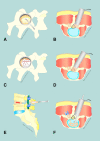Clinical Evaluation of Paraspinal Mini-Tubular Lumbar Decompression and Minimally Invasive Transforaminal Lumbar Interbody Fusion for Lumbar Spondylolisthesis Grade I with Lumbar Spinal Stenosis: A Cohort Study
- PMID: 35620194
- PMCID: PMC9127301
- DOI: 10.3389/fsurg.2022.906289
Clinical Evaluation of Paraspinal Mini-Tubular Lumbar Decompression and Minimally Invasive Transforaminal Lumbar Interbody Fusion for Lumbar Spondylolisthesis Grade I with Lumbar Spinal Stenosis: A Cohort Study
Abstract
Objective: To investigate the clinical outcome data and difference in efficacy between paraspinal mini-tubular lumbar decompression (PMTD) and minimally invasive transforaminal lumbar interbody fusion (MIS TLIF) in the treatment of degenerative lumbar spondylolisthesis grade I with lumbar spinal stenosis (DLS-I-LSS).
Methods: Patients with DLS-I-LSS, who underwent PMTD or MIS TLIF from September 2017 to March 2020, were included retrospectively. The follow-up period was 24 months after surgery. Outcome measurements included the Oswestry disability index (ODI) score, visual analog scale (VAS) low back pain score, VAS leg pain score, surgical data, and adverse events.
Results: A total of 104 patients with DLS-I-LSS were included in this study. The average improvement in ODI at 12 months (2.0%, 95% CI, -5.7% to 1.8%; p = 0.30) and 24 months (1.7%, 95% CI, -2.7% to 6.1%; p = 0.45) after surgery between the two groups were not statistically significant. The improvement in VAS low back pain score after 24 months and improvement in VAS leg pain score were not significantly different between the two groups. Compared with the PMTD group, the MIS TLIF group had more estimated blood loss and longer hospital stays. The cumulative reoperation rates were 5.66% and 1.96% in the MIS TLIF and PMTD groups, respectively (p = 0.68). The results of multivariate analysis showed that BMI, diabetes, and baseline ODI score were the main factors influencing the improvement in ODI in patients with DLS-I-LSS after minimally invasive surgery, accounting for 50.5% of the total variance.
Conclusions: The clinical effectiveness of PMTD was non-inferior to that of MIS TLIF for DLS-I-LSS; however, there was a reduced duration of hospital stay, operation time, blood loss, and hospitalization costs in the PMTD group. BMI, presence or absence of diabetes and baseline ODI score were influencing factors for the improvement of ODI (Trial Registration: ChiCTR2000040025).
Keywords: degenerative lumbar spondylolisthesis; lumbar spinal stenosis; minimally invasive spine surgery; minimally invasive transforaminal lumbar interbody fusion; paraspinal mini-tubular lumbar decompression.
Copyright © 2022 Liang, Xu, Rao, Chen, Wang and Chen.
Conflict of interest statement
The authors declare that the research was conducted in the absence of any commercial or financial relationships that could be construed as a potential conflict of interest.
Figures



Similar articles
-
Comparison of 270-degree percutaneous transforaminal endoscopic decompression under local anesthesia and minimally invasive transforaminal lumbar interbody fusion in the treatment of geriatric lateral recess stenosis associated with degenerative lumbar spondylolisthesis.J Orthop Surg Res. 2023 Mar 9;18(1):183. doi: 10.1186/s13018-023-03676-x. J Orthop Surg Res. 2023. PMID: 36895012 Free PMC article.
-
A comparison of minimally invasive transforaminal lumbar interbody fusion and decompression alone for degenerative lumbar spondylolisthesis.Neurosurg Focus. 2019 May 1;46(5):E13. doi: 10.3171/2019.2.FOCUS18722. Neurosurg Focus. 2019. PMID: 31042655
-
Comparison of lumbar endoscopic unilateral laminotomy bilateral decompression and minimally invasive surgery transforaminal lumbar interbody fusion for one-level lumbar spinal stenosis.BMC Musculoskelet Disord. 2020 Nov 27;21(1):785. doi: 10.1186/s12891-020-03820-2. BMC Musculoskelet Disord. 2020. PMID: 33246434 Free PMC article.
-
Minimally invasive transforaminal lumbar interbody fusion versus oblique lateral interbody fusion for lumbar degenerative disease: a meta-analysis.BMC Musculoskelet Disord. 2021 Sep 18;22(1):802. doi: 10.1186/s12891-021-04687-7. BMC Musculoskelet Disord. 2021. PMID: 34537023 Free PMC article.
-
Endoscopic Lumbar Interbody Fusion, Minimally Invasive Transforaminal Lumbar Interbody Fusion, and Open Transforaminal Lumbar Interbody Fusion for the Treatment of Lumbar Degenerative Diseases: A Systematic Review and Network Meta-Analysis.Global Spine J. 2024 Jan;14(1):295-305. doi: 10.1177/21925682231168577. Epub 2023 Mar 31. Global Spine J. 2024. PMID: 36999647 Free PMC article. Review.
Cited by
-
Rate of Reoperation Following Decompression-Only Procedure for Lumbar Degenerative Spondylolisthesis: A Systematic Review of Literature.JB JS Open Access. 2024 Jul 5;9(3):e23.00163. doi: 10.2106/JBJS.OA.23.00163. eCollection 2024 Jul-Sep. JB JS Open Access. 2024. PMID: 38974406 Free PMC article. Review.
-
A systematic review and meta-analysis of risk factors for reoperation after degenerative lumbar spondylolisthesis surgery.BMC Surg. 2023 Jul 5;23(1):192. doi: 10.1186/s12893-023-02082-8. BMC Surg. 2023. PMID: 37407952 Free PMC article.
-
Balancing ability of patients with lumbar spinal canal stenosis.Eur Spine J. 2023 Dec;32(12):4174-4183. doi: 10.1007/s00586-023-07782-6. Epub 2023 May 22. Eur Spine J. 2023. PMID: 37217822
References
LinkOut - more resources
Full Text Sources

